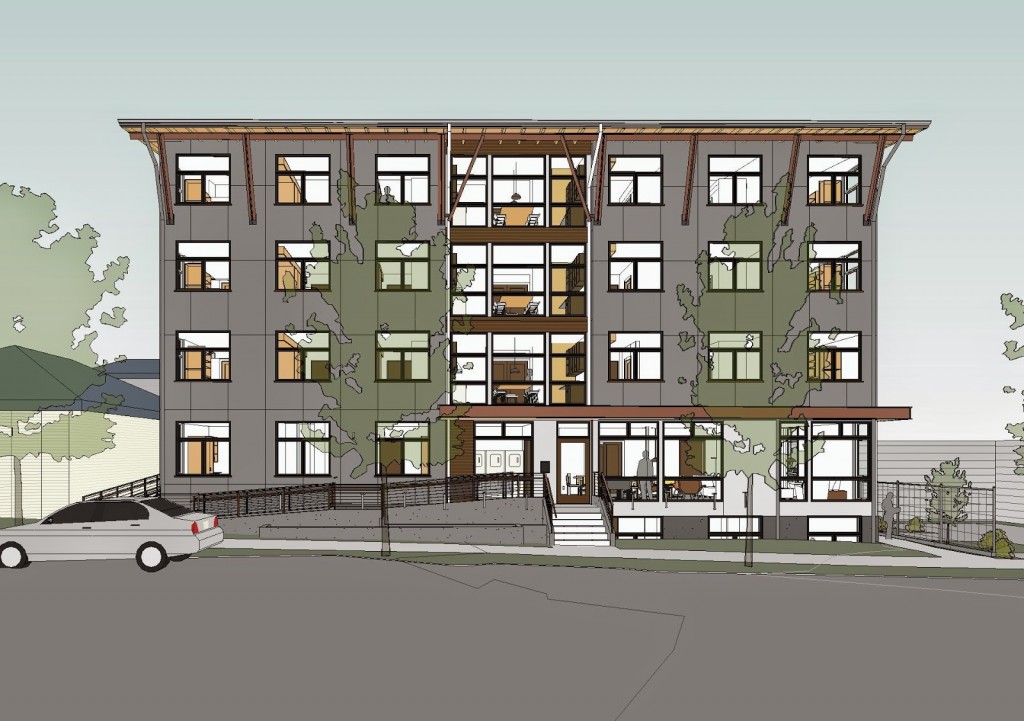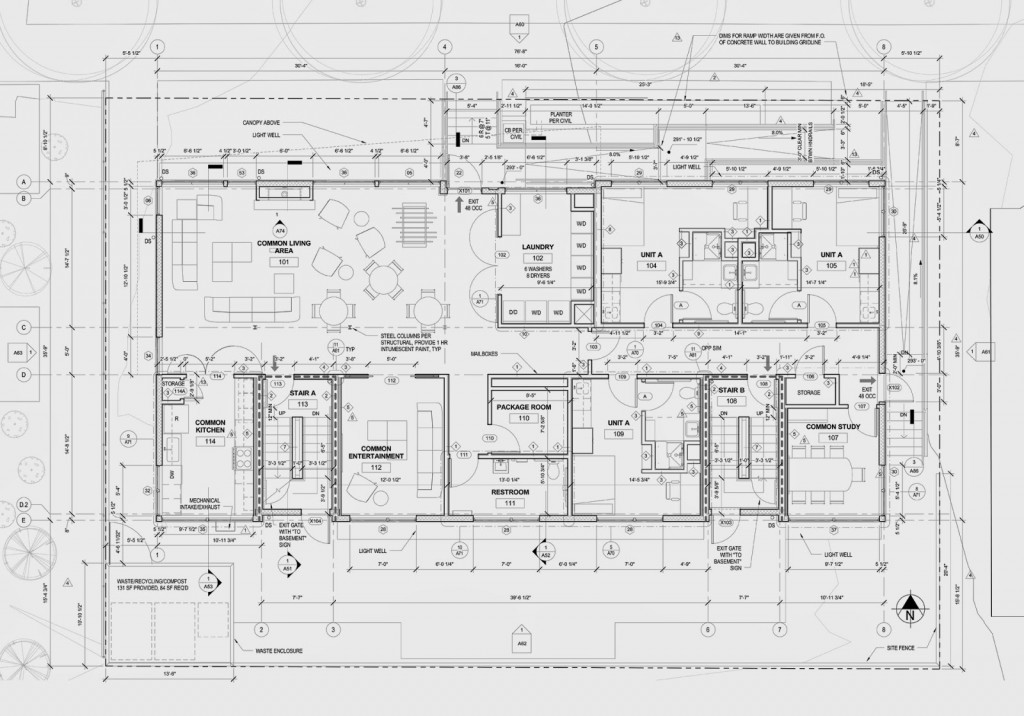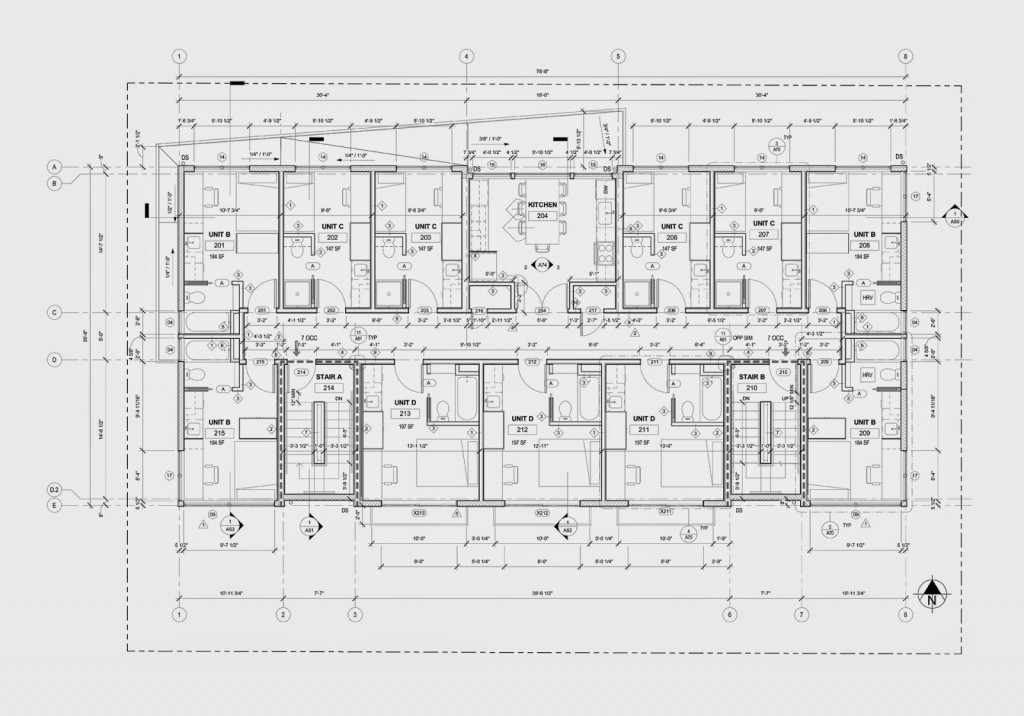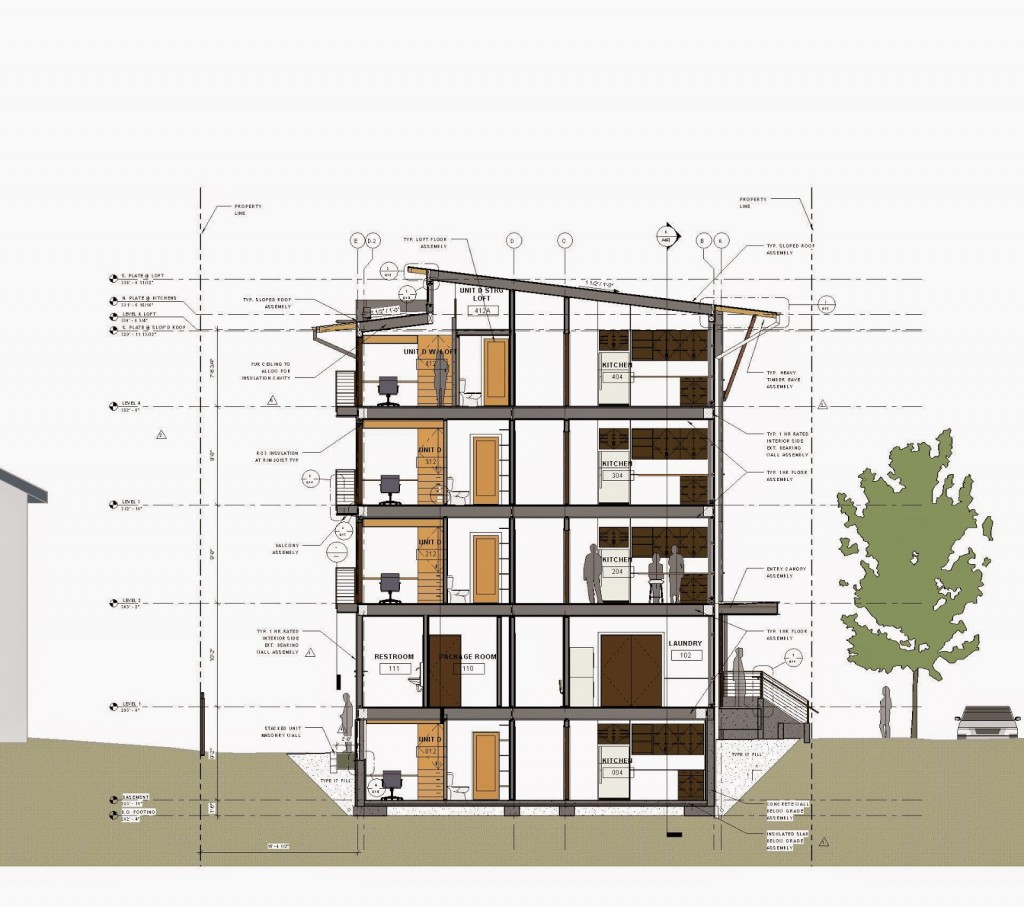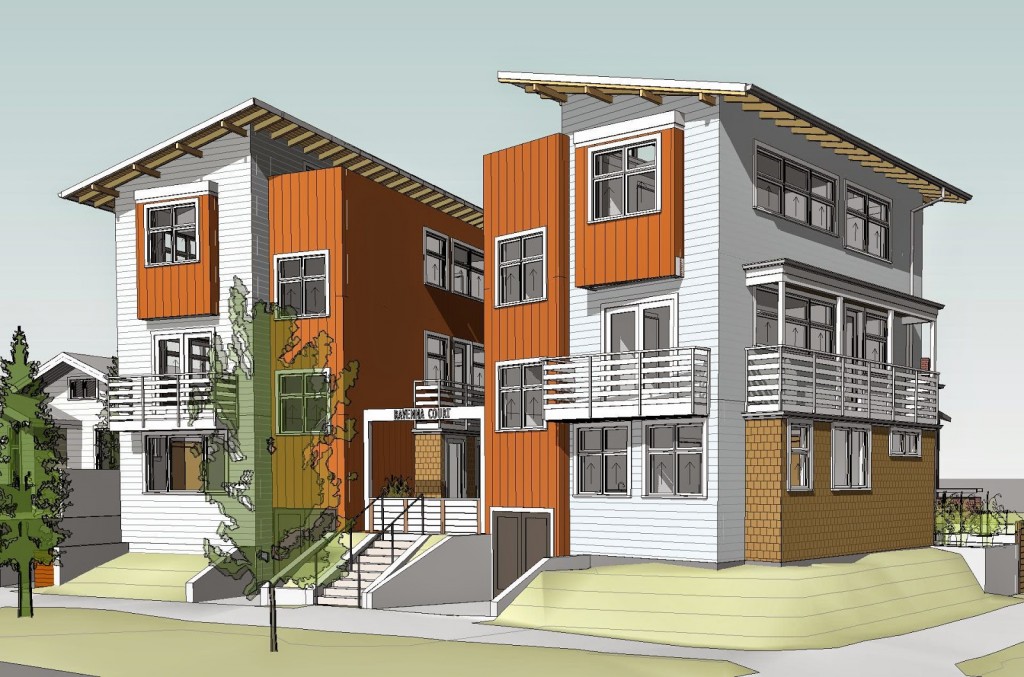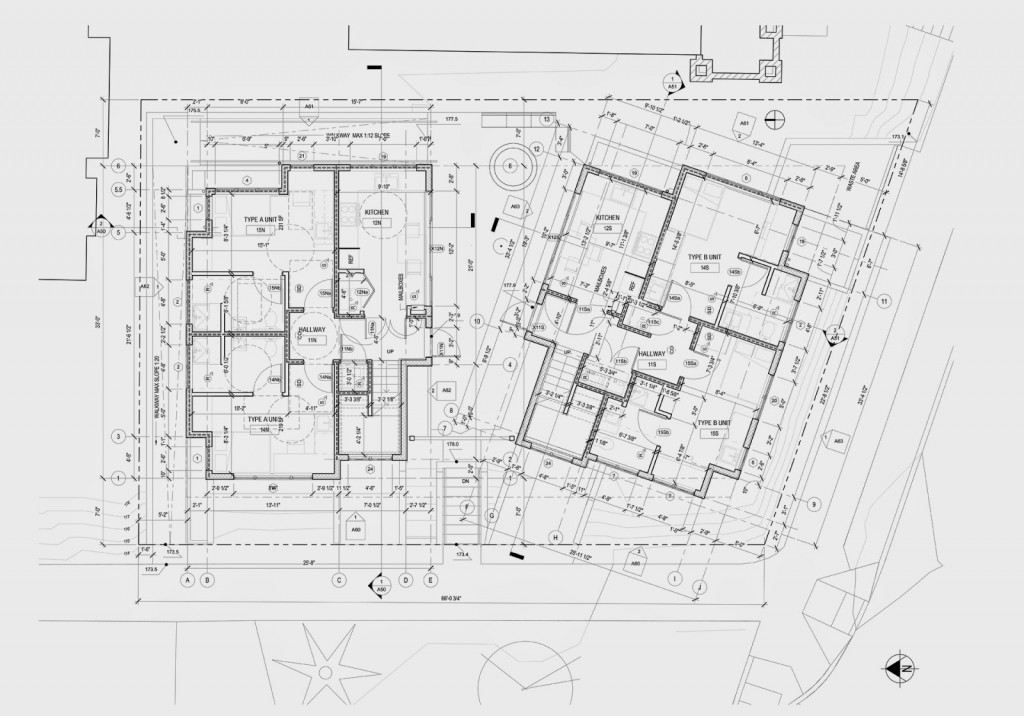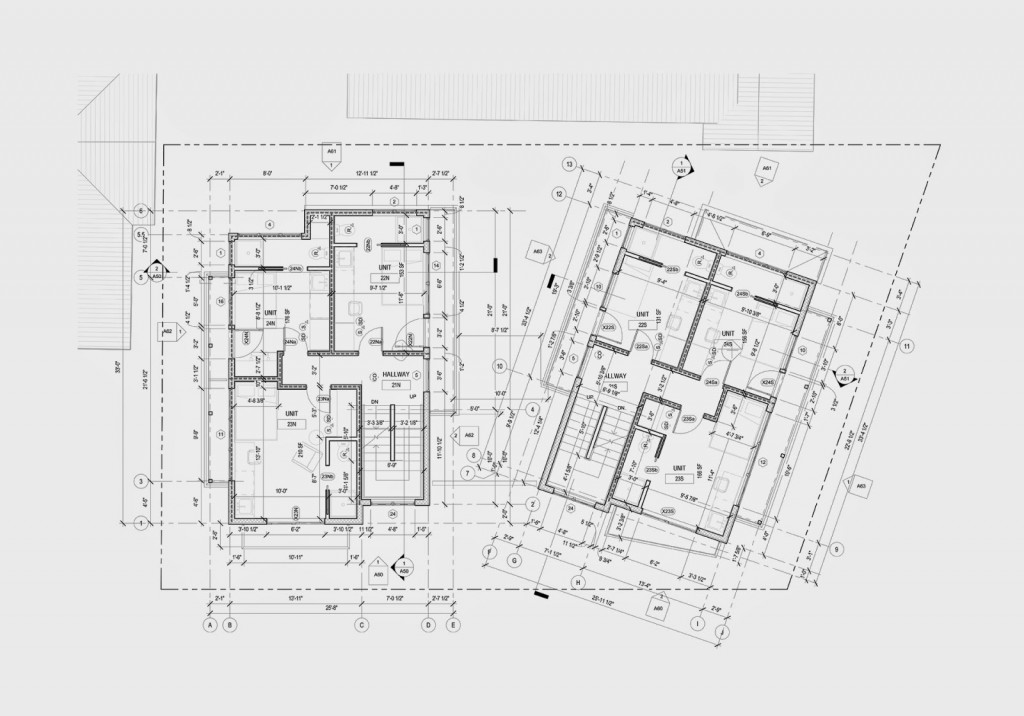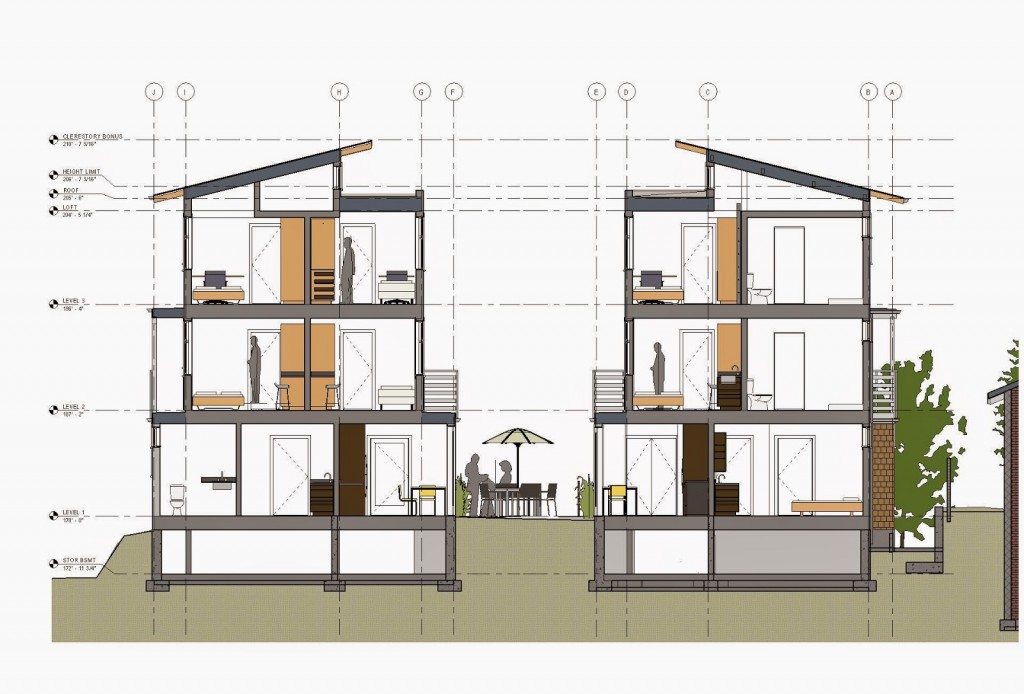Editor’s note: This is a cross-post by David Neiman, founder of Neiman Taber Architects, a local architecture firm that designs microhousing projects.
We recently designed a couple of micro-housing projects (one under construction and one about to begin) that have pushed the envelope in terms of small-unit housing. Both projects began with clients that gave us a mandate to design micro housing that would support and build community among residents, fit well into its neighborhood, and be a desirable place to live–not just a cheap one.
As the city council seems suddenly poised to regulate private congregate housing out of existence, we thought it would be a good opportunity to review these projects in some detail.
Marion Micros–1215 E Marion St
Marion Micros is one of the first micro projects to abandon the “eight rooms per kitchen” model entirely. Technically, this project is instead defined as congregate housing. The upper floors and the basement have 9-11 units per floor with a shared kitchen in the middle. Unit sizes vary from 150 sf to 240 sf. The majority of the main floor is reserved for very generous common areas–an open lounge, an event kitchen, a TV lounge, a study hall, and a laundry area. There is a single entry to the building. The pathway to get from the front door to the units cuts through the commons, increasing opportunities for the kind of chance interaction that builds community. The laundry area isn’t shunted off to a corner of the basement. It sits in an open glassy room next to the entry lounge, so that doing your laundry and waiting for it has the option to be a social experience, not just a chore. The commons is a space that can be programmed–it can facilitate organized activities like a shared dinner or a movie night. While the large commons on the first floor is a living room at the building scale, the kitchen provided on all other levels acts as a sort of “pajama commons,” where immediate neighbors can casually interact.
Ravenna Micros–900 NE Ravenna Blvd
Ravenna Micros is one of the smallest micro projects to date–16 units built as two free standing structures on a corner lot near the Roosevelt Station Area. While the scale of the project and the constrained nature of the site are a bit limiting, the project employs the same community-building strategies as the Marion project. The project entry is through a shared courtyard between the two buildings. The common kitchens face each other across the courtyard, and each kitchen has a big sliding door that can be opened up in good weather. All of these features are designed to maximize opportunities for chance interaction and to provide a staging area for simple gatherings.
Unit size
The current legislation proposes a minimum of 220 sf for small studio apartments as a minimum standard of habitability. The average room size in both projects is about 177 sf, but there are also common spaces in addition to the private rooms. When you include and pro-rate all of the common space, Marion and Ravenna have an average unit size of 226 sf and 204 sf respectively. In the case of Marion, it’s really not more “dense” than a conventional studio apartment building. Rather, the building areas have been re-allocated with a little less going into the individual private rooms and more going into the commons. Which is better for human welfare–a little more private space with more isolation, or a little less private space and more interaction with your neighbors? I’m not sure there is a right answer, and I’m not sure it makes sense to for the council to outlaw one type and mandate the other.
Communal area
The current legislation proposes either 10% or 15% as a minimum amount of communal amenities in a congregate residence. Marion provides 27.2%. Ravenna provides 15%. The proposed requirement is not a difficult standard to meet. I take issue with one version of the legislation that would discount laundry areas as communal amenities. We believe that these are exactly the kind of places where people meet, talk, and form the social glue of community. If laundry rooms are removed from communal area counts, they are essentially mandated to become as small as possible. Anyone who proposes a generous laundry room is essentially penalizing themselves, since their largess is not recognized by the code as an amenity.
Sinks
The projects have only one sink per unit. Currently, there is a great kerfuffle going on about the number of sinks in a unit and whether or not it should be acceptable for a unit to have less than two sinks (one in the bathroom, one in the kitchenette). Ironically, in both projects DPD would not allow us to have two sinks. In Marion we were forced to remove them from the larger bathrooms. In Ravenna, the bathrooms are so compact that we did not propose a second sink. In a very small unit the bathroom is so small, and the kitchenette so close, that a sink outside the bathroom is just as close as one inside (picture your last hotel room). In a larger unit (180 sf and up) the bathroom is generally big enough that including a sink is easy, and so it is provided. The sink count issue is one that, if left alone, really takes care of itself.
Bike parking
Neither project has much bike parking, but not because the owners didn’t want to provide it. For the Ravenna project, the intent was to provide the whole basement as bike parking and storage, but the basement in this type of building is not exempt from FAR, so there was no place to put it. Marion has an FAR exempt basement, but it is not an elevatored building, so all common amenities (bike room included) must be on the accessible main level. Either project could have provided secure, covered bike parking outside, but the roof cover is not allowed in the building setbacks and the bike parking area subtracts from the ground based amenity area, a standard which is often a difficult one for apartments to meet. If the city wants more bike parking, they should make it easier for projects to provide it.
By the numbers
Here’s the breakdown for Marion and Ravenna. It is our hope that a fair viewing of these projects could inject a little empirical data and some perspective into a legislative process that has been lacking both.
| Metric | Marion | Ravenna |
|---|---|---|
| Net Rentable Area | 7,995 sf | 2,834 sf |
| Common Amenities | 2,172 sf | 424 sf |
| Circulation | 3,121 sf | 914 sf |
| Utilities | 313 sf | 0 sf |
| Total Non-Rentable | 5,606 sf | 1,338 sf |
| Total GSF | 13,601 sf | 4,172 sf |
| Efficiency | 58.78% | 67.90% |
| Efficiency Incl. Commons | 74.75% | 78.10% |
| Number of Units | 45 | 16 |
| Lot Size | 5,820 sf | 3,479 sf |
| Density (Lot Size / Units) | 117 sf | 217 sf |
| Common Amenity Area | 2,172 sf | 424 sf |
| Net Rentable Area | 7,995 sf | 2,834 sf |
| Rentable + Common | 10,167 sf | 3,258 sf |
| Number of Units | 45 | 16 |
| Average Unit Size | 178 sf | 177 sf |
| Average Unit + Common | 226 sf | 204 sf |
| Common / Average Unit | 27.20% | 15.00% |

David Neiman
David Neiman, AIA is a partner at Neiman Taber Architects, an award-winning Seattle firm specializing in urban housing with a focus on issues of livability, affordability, community, and access to housing for all. Through a combination of innovative design, involvement in public policy, and development of his own projects, he has helped to pioneer new approaches to housing in Seattle and to shape the regulations that guide its development. A 4th generation Seattleite, he holds architecture degrees from the University of Washington and the University of Pennsylvania, and is a licensed architect in the state of Washington. He is a past member of the Seattle’s Housing Affordability and Livability Agenda (HALA) Committee and chair of the NW Design Review Board.


